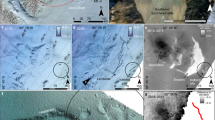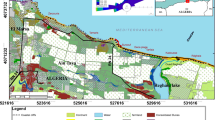Abstract
Antarctic tabular icebergs are important active components in the ice sheet-ice shelf-ocean system. Seafloor topography is the key factor that affects the drifting and grounding of icebergs, but it has not been fully investigated. This study analyzes the impact of seafloor topography on the drifting and grounding of Antarctic tabular icebergs using Bedmap-2 datasets and iceberg route tracking data from Brigham Young University. The results highlight the following points. (1) The quantitative distributions of iceberg grounding events and the tracking points of grounded icebergs are mainly affected by iceberg draft and reach their peak values in sea water with depths between 200 m and 300 m. The peak tracking point number and linear velocity of free-drifting icebergs are found in the Antarctic Slope Front (water depth of approximately 500 m). (2) The area of possible grounding regions of small-scale icebergs calved from ice shelf fronts accounts for 28% of the sea area at water depths less than 2000 m outside the Antarctic coastline periphery (3.62 million km2). Their spatial distribution is mainly around East Antarctica and the Antarctic Peninsula. The area of possible grounding regions of large tabular icebergs with long axes larger than 18.5 km (in water depths of less than 800 m) accounts for 74% of the sea area. (3) The iceberg drifting velocity is positively correlated with ocean depth in areas where the depth is less than 2000 m (R=0.85, P<0.01). This result confirms the effect of water depth variations induced by seafloor topography fluctuations on iceberg drifting velocity.
Similar content being viewed by others
References
Bindoff N L, Rosenberg M A, Warner M J. 2000. On the circulation and water masses over the Antarctic continental slope and rise between 80° and 150°E. Deep-Sea Res Part II-Top Stud Oceanogr, 47: 2299–2326
Bohlander J, Scambos T. 2007. Antarctic coastlines and grounding line derived from MODIS Mosaic of Antarctica (MOA). Boulder: National Snow and Ice Data Center
Chen Y, Sun B, Liu C, Cui X B, Wang T T. 2014. The analysis of a new Antarctic topography database: Bedmap-2 (in Chinese). Chin J Polar Res, 26: 254–261
Dowdeswell J A, Bamber J L. 2007. Keel depths of modern Antarctic icebergs and implications for sea-floor scouring in the geological record. Mar Geol, 243: 120–131
Fretwell P, Pritchard H D, Vaughan D G, Bamber J L, Barrand N E, Bell R, Bianchi C, Bingham R G, Blankenship D D, Casassa G, Catania G, Callens D, Conway H, Cook A J, Corr H F J, Damaske D, Damm V, Ferraccioli F, Forsberg R, Fujita S, Gim Y, Gogineni P, Griggs J A, Hindmarsh R C A, Holmlund P, Holt J W, Jacobel R W, Jenkins A, Jokat W, Jordan T, King E C, Kohler J, Krabill W, Riger-Kusk M, Langley K A, Leitchenkov G, Leuschen C, Luyendyk B P, Matsuoka K, Mouginot J, Nitsche F O, Nogi Y, Nost O A, Popov S V, Rignot E, Rippin D M, Rivera A, Roberts J, Ross N, Siegert M J, Smith A M, Steinhage D, Studinger M, Sun B, Tinto B K, Welch B C, Wilson D, Young D A, Xiangbin C, Zirizzotti A. 2013. Bedmap2: Improved ice bed, surface and thickness datasets for Antarctica. Cryosphere, 7: 375–393
Garabato A C N, Polzin K L, King B A, Heywood K J, Visbeck M. 2004. Widespread intense turbulent mixing in the Southern Ocean. Science, 303: 210–213
Gladstone R, Bigg G R. 2002. Satellite tracking of icebergs in the Weddell Sea. Antarctic Sci, 14: 278
Gladstone R M, Bigg G R, Nicholls K W. 2001. Iceberg trajectory modeling and meltwater injection in the Southern Ocean. J Geophys Res, 106: 19903–19915
Grosfeld K, Schröder M, Fahrbach E, Gerdes R, Mackensen A. 2001. How iceberg calving and grounding change the circulation and hydrography in the Filchner Ice Shelf-Ocean System. J Geophys Res, 106: 9039–9055
Heywood K J, Locarnini R A, Frew R D, Dennis P F, King B A. 1998. Transport and water masses of the Antarctic Slope Front system in the eastern Weddell Sea. Ocean, Ice, and Atmosphere: Interactions at the Antarctic continental margin. Antarct Res Ser, 75: 203–214
Hunke E C, Comeau D. 2011. Sea ice and iceberg dynamic interaction. J Geophys Res, 116: C05008
Jacobs S S, Helmer H H, Doake C S M, Jenkins A, Frolich R M. 1992. Melting of ice shelves and the mass balance of Antarctica. J Glaciol, 38: 375–387
Jacobs S S. 1991. On the nature and significance of the Antarctic Slope Front. Mar Chem, 35: 9–24
Kuijpers A, Dalhoff F, Brandt M P, Hümbs P, Schott T, Zotova A. 2007. Giant iceberg plow marks at more than 1 km water depth offshore West Greenland. Mar Geol, 246: 60–64
Liu Y, Moore J C, Cheng X, Gladstone R M, Bassis J N, Liu H, Wen J, Hui F. 2015. Ocean-driven thinning enhances iceberg calving and retreat of Antarctic ice shelves. Proc Natl Acad Sci USA, 112: 3263–3268
Liu Y, Cheng X, Hui F M, Wang X W, Wang F, Cheng C. 2013. Antarctic iceberg calving monitoring based on Envi Sat ASAR images (in Chinese). J Remot Sens, 17: 479–494
Liu Z, Zhao Z Y, Fan Y D, Tian D. 2013. Automated change detection of multi-level icebergs near Mertz Glacier region using feature vector matching. In: Proceedings of the International Conference on Image Processing, Computer Vision, and Pattern Recognition (IPCV). The Steering Committee of The World Congress in Computer Science, Computer Engineering and Applied Computing (WorldComp)
Long D G, Ballantyn J, Bertoia C. 2002. Is the number of Antarctic icebergs really increasing? Eos Trans AGU, 83: 469–474
MacAyeal D R, Okal M H, Thom J E, Brunt K M, Kim Y J, Bliss A K. 2008. Tabular iceberg collisions within the coastal regime. J Glaciol, 54: 371–386
Markus T. 1996. The effect of the grounded tabular icebergs in front of Berkner Island on the Weddell Sea ice drift as seen from satellite passive microwave sensors. In: Geoscience and Remote Sensing Symposium, 1996. IGARSS'96.' Remote Sensing for a Sustainable Future. Inter IEEE Xplore, 3: 1791–1793
Marshall D. 1995. Topographic steering of the Antarctic circumpolar current. J Phys Oceanogr, 25: 1636–1650
Núñez-Riboni I, Fahrbach E. 2009. Seasonal variability of the Antarctic coastal current and its driving mechanisms in the Weddell Sea. Deep-Sea Res Part I-Oceanogr Res Pap, 56: 1927–1941
Remy J P, Becquevort S, Haskell T G, Tison J L. 2008. Impact of the B-15 iceberg “stranding event” on the physical and biological properties of sea ice in McMurdo Sound, Ross Sea, Antarctica. Antarct Sci, 20: 593–604
Rignot E, Mouginot J, Scheuchl B. 2011. Antarctic grounding line mapping from differential satellite radar interferometry. Geophys Res Lett, 38: L10504
Robinson N J, Williams M J M. 2012. Iceberg-induced changes to polynya operation and regional oceanography in the southern Ross Sea, Antarctica, from in situ observations. Antarct Sci, 24: 514–526
Silva T A M, Bigg G R, Nicholls K W. 2006. Contribution of giant icebergs to the Southern Ocean freshwater flux. J Geophys Res, 111: C03004
Tamura T, Williams G D, Fraser A D, Ohshima K I. 2012. Potential regime shift in decreased sea ice production after the Mertz Glacier calving. Nat Commun, 3: 826
Tchernia P, Jeannin P F. 1984. Circulation in Antarctic waters as revealed by iceberg tracks 1972–1983. Polar Record, 22: 263–269
Woodworth-Lynas C M T, Simms A, Rendell C M. 1985. Iceberg grounding and scouring on the Labrador Continental Shelf. Cold Regions Sci Tech, 10: 163–186
Acknowledgements
We thank the British Antarctic Survey for providing the Bedmap-2 dataset, and Brigham Young University for making available the iceberg tracking data. This study was supported by the National Key Research and Development Program of China (Grant No. 2016YFA0600103), the National Natural Science Foundation of China (Grant Nos. 41406211, 41476161, 41676182 & 41676176), the National Basic Research Program of China (Grant No. 2012CB957704), the Key Laboratory Research Fund of the National Administration of Surveying, Mapping and Geoinformation of China (Grant No. 201416), the Specialized Research Fund for the Doctoral Program of Higher Education (Grant No. 20120003110030), and the Project of International Cooperation and Exchanges CHINARE (Grant No. 201611).
Author information
Authors and Affiliations
Corresponding author
Rights and permissions
About this article
Cite this article
Li, T., Liu, Y., Cheng, X. et al. The effect of seafloor topography in the Southern Ocean on tabular iceberg drifting and grounding. Sci. China Earth Sci. 60, 697–706 (2017). https://doi.org/10.1007/s11430-016-9014-5
Received:
Accepted:
Published:
Issue Date:
DOI: https://doi.org/10.1007/s11430-016-9014-5




